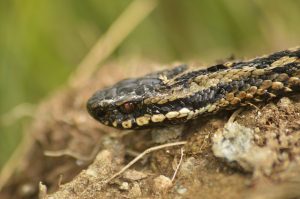Estimated reading time: 4 minutes

Table of contents
We are lucky in the UK because we don’t have many snakes. The grass snake is healed, and the European Adder (Vipera berus) is the only poisonous snake found in the UK. While we don’t see that many snakes they exist in the UK, both the grass snake and Adder are relatively shy and small compared to Pythons, etc. However, grass snakes can get as big as 2 metres, the current social distancing space in the UK.
Because snakes are shy, there is a good chance your dog won’t ever see a snake, but it is something that cannot be ruled out. Adders are poisonous, but if you quickly act, the survival rate is very high (around 95%) but fatal if you delay action.
Snakes are both a Spring and Summer danger.
How to identify Grass Snakes
Grass snakes can stay underwater for up to an hour, which is why they are generally found around ponds and meadows. Grass Snakes can be identified by their greenish-grey skin in a darker colour down their backs.
Are Grass Snakes dangerous?
As previously mentioned, grass snakes are not poisonous and whilst being on the bigger side, up to 2m, they are not dangerous; however, be warned they can bite and puncture your dogs’ skin if they are backed into a corner which will be painful and run the risk of infection so should be checked by a vet should this happen.
Grass snakes also defend themselves by admitting a foul-smelling door to deter whatever is trying to attack i
What do Adders look like?
Adders usually grow to around 50 – 60cm, although they can get as big as 90cm. The body has a zig-zag pattern, and the head has a distinctive V-shaped marking. Their natural habitat is at the edges of fields, woodland, and sandy areas. You will also find Adders on top of heathers, and they love to lie sun. They curl up inside the heather to shelter if the weather is terrible.
Are adders poisonous?
The Adder is the only poisonous or venomous snake in the UK. As a result, they can prove dangerous if your dog is unlucky to be bitten. The venom is relatively mild compared to many other snakes but requires immediate attention from your vet to give the antidote. In a few cases, bites from an Adder. It can be fatal.
Unfortunately, snake bites are not always easy to fund. One of the reasons is that the snake will do its best to remain hidden. As a result, you may not realise that your dog has been bitten when it makes a noise, let alone suspect a snake. If you have been in a wooded area to check your dog for any red, tender, sore, hot or painful spots on its body, this could warrant further investigation.
As with any issues with your dog, phone the vet Symptoms of a snake bite if in doubt.
What should I look for if my dog gets bitten by a snake?
- Two minor puncture marks along with bruising and possibly blood
- Swelling – although this can take up to 2 hours.
- Nervousness or yelping
- Drooling
- Possibly breathing problems depending on where the bite is
- Vomiting
- Lameness
- Seizures
What you can do yourself
- Stay Calm – A stressed dog can lead to a faster blood floor and result in the poison spreading quicker.
- Contact the nearest vet and advise them that an adder has bitten your dog so they can have the antidote ready.
- Do NOT suck the bite site.
- Bathe the area in cold water to help control the swelling.
- Carry your pet, if possible, to minimise the spread of venom around the body.
- Keep your pet quiet and still on the way to the clinic.
Here at Finchley Dog Walker, we are First Aid Trained to cope with most incidents.
Below are some other summer-related articles I think you might be interested in
Disclaimer: Derek Chambers, aka Finchley Dog Walker, is not a vet, and this article is not designed to replace veterinary advice. However, I would like to thank Zoe from The Friendly Pet Nurse for her guidance and input in the post.
We recommend do an online first aid course such as

